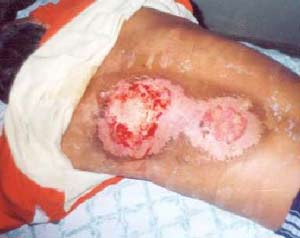Health Concerns
The science of radiation protection, or "health physics" as it is more properly called, grew out of the parallel discoveries of x-rays and radioactivity in the closing years of the 19th century. Since early workers with gamma and x-radiation took few, if any, precautions, serious injuries inevitably occurred. Radiation burns were recorded within a month of Roentgen’s announcement of his discovery of x-rays. Becquerel burned himself by carrying a sample of radium in his pocket. Marie and Pierre Curie received radiation burns on their skin from working with radium, and it is suspected their lives were cut short because of exposure to large amounts of radiation. Many developed skin cancer and suffered amputations of fingers and hands as a result of high exposures of radiation. By the 1922, radiation exposure had caused over 150 deaths.
As early as 1900, five years after Roentgen’s discovery, it was understood that precautions needed to be taken when working with x- and gamma radiation. The first warning of possible adverse effects of x-rays came from Thomas Edison, William J. Morton, and Nikola Tesla who each reported eye irritations from experimentation with x-rays and fluorescent substances. Studies of the effects of radiation on living tissue were initiated and the development of safe working practices began. In the 1920’s, the routine use of film badges for personnel monitoring was introduced and the genetic effects of x- and gamma rays were recognized. Adoption of the Roentgen as a unit for measuring radiation by the Second International Congress on Radiation occurred in 1928.
Today, it can be said that radiation ranks among the most thoroughly investigated causes of disease. Although much still remains to be learned, more is known about the mechanisms of radiation damage on the molecular, cellular, and organ system than is known for most other health stressing factors. Moreover, it is the vast accumulation of quantitative dose-response data that enables health physicists to specify radiation levels so that medical, scientific, and industrial uses of radiation may continue at levels of risk comparable with the risks associated with any other technology.
 The image on the right shows severe radiation burns on the back of a man. The man was one of three woodsmen who found a pair of canisters in the mountains of the country of Georgia (formally part of the USSR). The men did not know the canisters were intensely radioactive relics that were once used to power remote generators. Since the canisters gave off heat, the men carried them back to their campsite to warm themselves on a cold winter night.
The image on the right shows severe radiation burns on the back of a man. The man was one of three woodsmen who found a pair of canisters in the mountains of the country of Georgia (formally part of the USSR). The men did not know the canisters were intensely radioactive relics that were once used to power remote generators. Since the canisters gave off heat, the men carried them back to their campsite to warm themselves on a cold winter night.